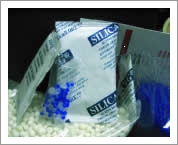A: A desiccant is a hydrating agent which attracts moisture from the atmosphere. It adsorbs and holds particles of water to itself.
Q: What are the three major types of desiccants?
A:
1) Silica Gel Synthetic-A form of silica manufactured from sodium silicate and sulfuric acid. Like Clay, Silica Gel is non-hazardous and is capable of adsorbing 40% of its weight in water vapor at 100% humidity. Silica Gel has a porous molecular structure that closely resembles a sponge, and has the highest capacity of any commercial desiccant for moisture adsorption.2) Indicating Silica Gel-Color changes to indicate moisture content / ( Similar features as the the above )3) Silica Gel Natural-A manufactured crystalline version of Zeolite containing a network of uniform pores and empty cavities. It is derived from sodium potassium or calcium alumina silicate and heat up to 300 C for 8 hours. The desiccant of choice for the most line and common applications. It is the cheapest of the primary desiccants.*Carbon-Although not a desiccant, Carbon is often used alone or in blends in packaging applications where odor is an issue (i.e. vitamin packaging).
Q: What sizes are available?
A: All three major types of desiccants are available in fractional gram sizes through 1 Grams to 1000 Grams unit pack. Our Silica gel is also available in No Woven Bags, as well as custom blends of two or more desiccants.
Q: What are Humidity Indicating Cards (HIC Cards)?
A: HIC Cards are cards designed to measure the humidity level within a packaged environment. Our HIC Cards are broken down as follows:
One Dot: 8%
Three Dots: 10%-30%, 30%-50%
Four Dots: 10%-40%
Six Dots: 10%-60%
Q: How are desiccants best used?
A: To be used most effectively, desiccants should be used within a closed/sealed moisture barrier, or a rigid/sealed container. Humidity indicating cards are generally placed inside the container to show the humidity level and indicate when the desiccant needs to be replaced.
Q: Who are our customers?
A: Electronic Parts, Computers, Pharmaceutical and Vitamin Packaging, Metal Parts, Food Packaging, Aerospace, Pet Foods, Leather Products, Metal Powders, Powdered or Beaded Glass, & Bulk Powdered Chemicals.
Q: How is SILICA G® desiccants packaged?
A: SILICA G® packages desiccants in LITHO paper (heat sealed), No Woven (heat sealed).
CONTAINER FACTS
Shipping and logistics managers should be more aware of the damage that humidity and condensation can inflict on their containerized cargoes.

MANY PROFESSIONALS
In the shipping and logistics industry do not see humidity and condensation as an obvious threat to their containerized goods – but they should do. Condensation trapped inside shipping containers can cause moisture damage including mould, mildew, rust and corrosion of the goods being shipped. Products such as coffee and cocoa beans, steel products, machinery, canned goods and pet food are all susceptible. Condensation can result in metal products turning rusty, agricultural cargoes going moldy and electronic goods malfunctioning.
Not only do today’s shipping and logistics managers have to worry about the method and timing of their shipments. They must also seriously evaluate the integrity of product packaging while their goods are in transit.
CLIMATE CHANGE
Normally goods are paced inside boxes, drums, crates, plastic bags, etc. prior to loading into the container for shipment. Once in transit, the goods can be adversely affected by sudden changes in climatic conditions. Often, “container rain” forms on the inner walls and ceilings of the container this is caused when the dew point temperature reaches actual temperature inside the container.Condensation may be caused by a number of other external and internal factors, including the moisture content of wet or green-timber pallets, container ventilation holes, crossing climatic zones during transit and the process of loading the containers in humid environments. These variables are just a handful of the many conditions that may result in moisture related problems during transit.
SILICA G INDONESIA,
Contribution to the issue is FRESH DRY®, a moisture absorbent for use in freight containers. The product will keep mould, mildew, rust and corrosion at bay for over 50 days at a time and is capable of absorbing over 1.5 LITRES of moistures. FRSH DRY® will absorb more total moisture per 20ft or 40 ft container than other desiccants now on the markets at a lower cost per container. FRESH DRY® is also an environmentally safe product that can be disposed of as normal waste.
About proper packaging methods are also crucial. “Many of the customers that come to us do not use desiccants during transit and they call on us to help make packaging related recommendations.”